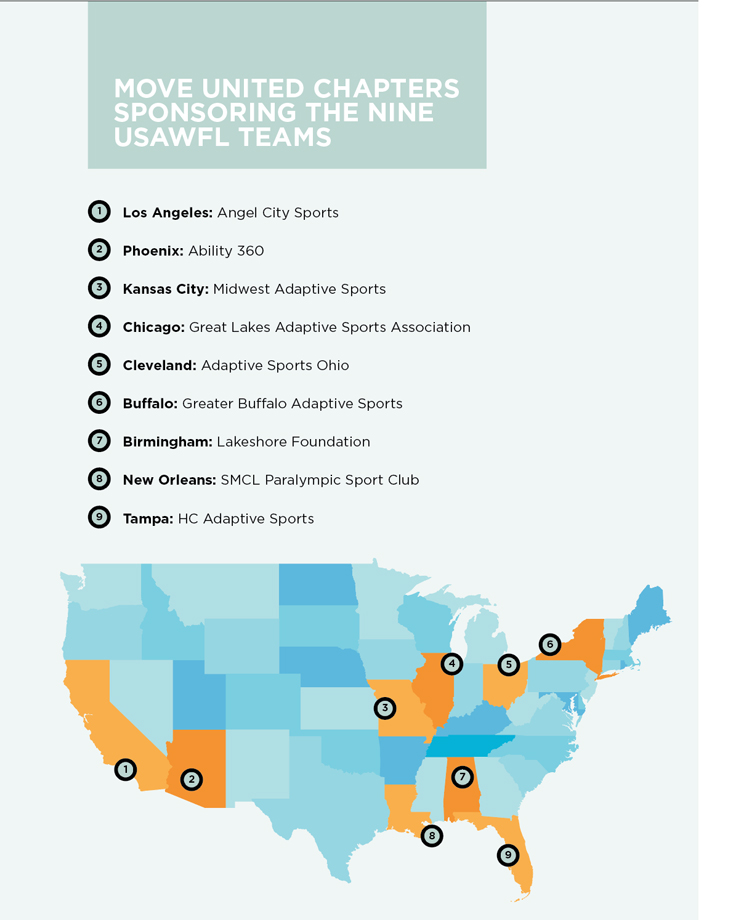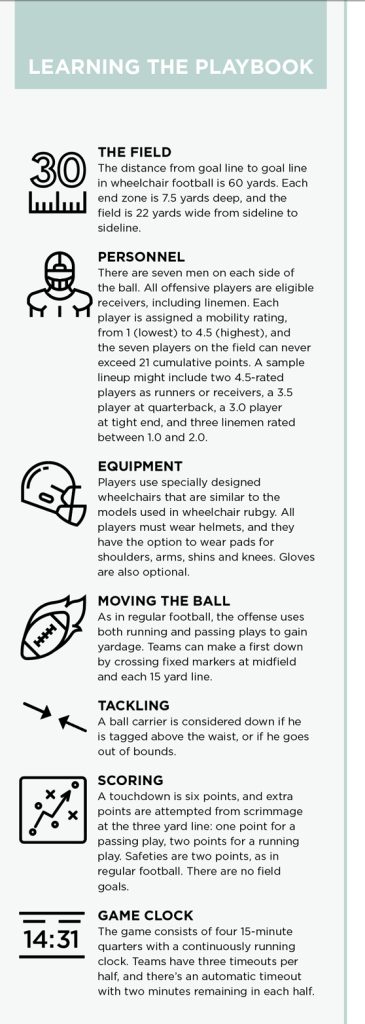Amputees will hit the gridiron this month as the USA Wheelchair Football League kicks off its inaugural season.

When Bart Salgado started playing wheelchair football in the late 1990s, the biggest event of each season was known as the Blister Bowl. “It was appropriately named,” Salgado says. “I ended up with about 16 blisters all over my hands.”
He remembers those scars with great fondness for a couple of reasons. They call to mind the formative years of an adaptive sport that’s now enjoying a huge spike in popularity. And they signify the combination of toughness, speed, agility, and brute force that make wheelchair football so much fun to play.
“We call it full-contact, because we can basically bear down on somebody at full speed and really blast them,” says Salgado, a bilateral amputee who lives near Los Angeles. “That’s one of the things we love about our game.”
Salgado is betting fans and sponsors will embrace the game, too. He’s one of the prime organizers of the USA Wheelchair Football League, which kicks off its inaugural season this fall with nine teams from all parts of the country. With backing from Move United, the Bob Woodruff Foundation, and the National Football League itself, the USAWFL is betting that its unique variation on the nation’s favorite sport can find an audience.
“We’re excited, and we’re hoping it will really create some attention,” says Julia Ray, Move United’s director of programs. “There was a lot of demand for this, particularly among the [military] veteran community, and the NFL’s support gives us a lot of credibility. Some of our teams have been overwhelmed with interest [from players].”
The interest has existed for at least 25 years, but it’s been scattered in isolated pockets around the country. The Blister Bowl, generally thought to be the first organized tournament, was staged on Leadbetter Beach in Santa Barbara, California. Las Vegas hosted a large tournament in the early 2000s called the Xtreme Bowl, and a Texas-based league with about half a dozen teams operated for several years during the 2010s. That league staged Wheelchair Super Bowls in 2017 and 2018.

The USAWFL is the first attempt to implement the concept on a pro-style level. The league was supposed to debut in 2020 with four teams, and a big announcement was planned during ESPN’s national telecast of the NFL draft last April. Wheelchair player Brad Lang was slated to officially announce one of the draft selections for the Carolina Panthers. Unfortunately, the COVID pandemic scuttled those plans. The draft was held virtually rather than in person, costing the new league a chance at a high-profile introduction. In the end, the 2020 season had to be canceled altogether.
Rather than shrivel up, however, the USAWFL more than doubled in size during the intervening year. It will field nine teams in 2021, all of them sponsored by prominent Move United chapters. All but one is located in an NFL market, giving the league outstanding exposure among pro football fanatics. Kansas City’s USAWFL team will wear the same colors as the NFL’s Kansas City Chiefs and hold some of its practices at Arrowhead Stadium. Likewise, the Tampa Bay wheelchair team will share its name and colors with the NFL Buccaneers.
Once the final rosters are set, it’s likely that between 10 and 20 percent of the league’s players will be amputees. The lineups will blend longtime wheelchair football stalwarts such as Salgado (the player-coach of the Los Angeles team) with relative newcomers such as Kansas City star Kolton Kincaid, a former prep football phenom who suffered a spinal cord injury in 2015. Military veterans will also have a strong presence. “The NFL and the Bob Woodruff Foundation got involved as part of the NFL Salute to Service,” says Salgado, a former Marine. “Being a veteran myself, I knew this was something that’s needed in the community. My team has five veterans on it.”
All nine teams will convene for the inaugural USAWFL tournament on September 11-12 in Phoenix, hosted by Ability 360. Each team will play a minimum of three games over the weekend. A second tournament is on the schedule for October 30-31 in Chicago, hosted by Great Lakes Adaptive Sports Association.
The best way to follow the USAWFL is via Move United and the corresponding chapters. Amplitude will report out game results as well on our digital channels.




